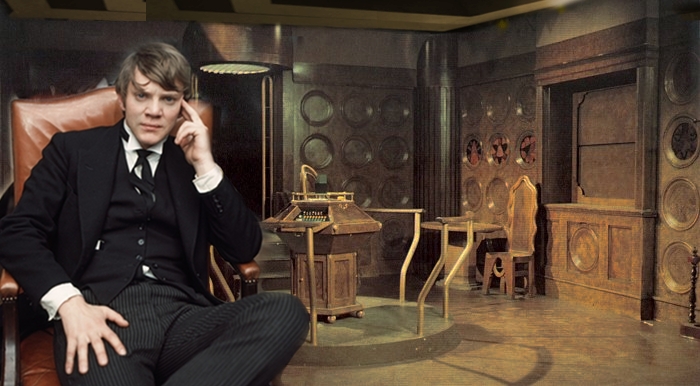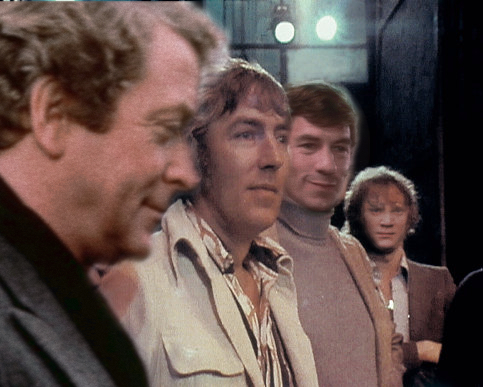 So, there’s a new season of Dr. Who, the decades-long BBC series aimed at delighting simple children and providing marginal employment to barely-employable minor Shakespearean character-actors. As surly Scottish grumpus Peter Capaldi takes over the role, let’s look back at some of the other unfortunates who have played this time-traveling weirdo.
So, there’s a new season of Dr. Who, the decades-long BBC series aimed at delighting simple children and providing marginal employment to barely-employable minor Shakespearean character-actors. As surly Scottish grumpus Peter Capaldi takes over the role, let’s look back at some of the other unfortunates who have played this time-traveling weirdo.

Dr. Who began in the early 1960s as a BBC show designed to make excruciatingly boring English history palatable to fussy schoolchildren. The Doctor was originally conceived as a professor-y type who would have fun yet educational adventures traveling through time. Producers hoped to find an English actor with some gravitas, yet who would need money badly enough to be in a crappy kid’s show. James Mason wasn’t broke enough. Claude Rains hadn’t burned through his “Lawrence of Arabia” money yet. Laurence Olivier was still a decade away from his “I’ll do anything for money” phase. David Niven, though, had acquired a wicked opium habit making “Around the World in 80 Days,” and was in need of a few quick paychecks. Eager to keep his knees from getting broken by displeased opium merchants, Niven signed up.

After two seasons of zipping around in a time-traveling police call-box with his traveling companion, Cyril, meeting Shakespearean bit-actors playing Charlemagne and Dickens and 39th-century space-king Zorgo the Mighty, Niven’s fear of Japanese opium gangsters had abated, and he was ready to move on. Producers had grown weary of catering to Niven’s whims, making episodes that consisted largely of Niven sitting in a drawing room drinking brandy with a random historical figure. They wanted to replace him with a younger, cheaper actor, and take the show in a more action-oriented science fiction direction. The final Niven episode, “Crisis on Ganymede,” introduced the idea of the Doctor “regenerating” and with a blaze of shoddy effects, the Doctor turned into another actor. David Niven cried, “Farewell, my friends!” and fell down, and Michael Caine stood up and uttered the immortal words, “Blimey! I’ve regenerated, mates!” TV history was born. In addition to the concept of regeneration, the Caine years introduced what would become another Dr. Who staple: alien planets that looked suspiciously like abandoned Welsh quarries. The show also largely abandoned any pretense at being educational, and the Second Doctor spent most of his time wandering around foggy gravel pits saying “Blimey” and being chased by marginally-threatening robots. Mildly menacing robots would thereafter forever be a part of Dr. Who. The same, alas, could not be said for Michael Caine. Stardom beckoned, and he left the show. In “Viceroy of Venus,” he gasped “Blimey, lads, I’m done for!” and transmogrified into starving Shakespearean actor Ian McKellan.

The year before he took the role of the Third Doctor, he had played Second Knight in the Old Vic production of Henry V. His big lines were “What ho, sirrah!” and “Aye, it be a hard cheese for the king.” McKellan was a skilled Shakespearean actor with bills to pay, which was the perfect combination for the misers at the BBC. With Caine’s departure, the already small budget was cut still further, and many of the McKellan shows were like tiny black box productions of Shakespeare plays with inexplicable tinfoil robots. McKellan had far fewer episodes in foggy gavel pits, and was mostly confined to the set of his time ship, the TARDIS, which was a shoddy thing decorated with light bulbs and pie pans. Alien planets were portrayed–sparingly–by relatively unconvincing painted backdrops.
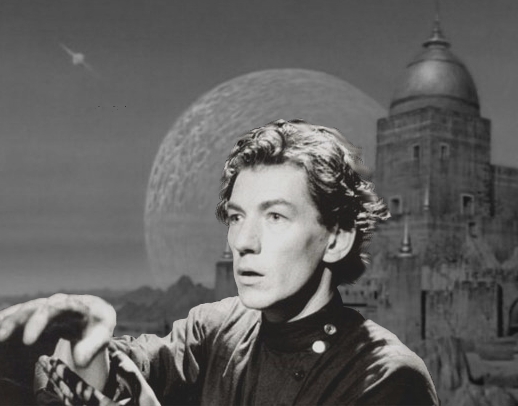
While Caine played the Doctor as a cocky loveable scamp, McKellan took a darker turn, portraying the Doctor as a grimmer, haunted figure. Tinfoil robots aside, it was pretty dark, like watching Space-Hamlet. Even his traveling companion was dark. Niven had traveled around with Cyril, a tiresome Edwardian schoolboy. Caine had Terrance, a World War I doughboy, and Wilfred, a Saxon knight. McKellan’s tenure started with poor Terrance getting killed off. McKellan’s companion was Marco, who he rescued from a medieval plague-stricken Verona in the aptly-titled episode, “The Black Plague.” The Third Doctor’s villains were more menacing, too, at least in the scripts if not in shoddily-produced appearance. The alien race, the Flatuloids, had been comic foils in a Niven episode in which the Doctor tried (with some success) to explain to Cyril both the Reformation and how the digestive tract worked. In “The Black Plague,” the Flatuloids noxious emissions were shown to be the cause of the epidemic that killed half of Europe. Though they were still played by sad English stuntmen in stifling rubber suits, the silly farting aliens made the transition into being–along with the robotic Mandroids–the central recurring villains of the series. Needless to say, the show had long since abandoned any pretense at being educational. Bubonic plague is not caused by alien gasses.
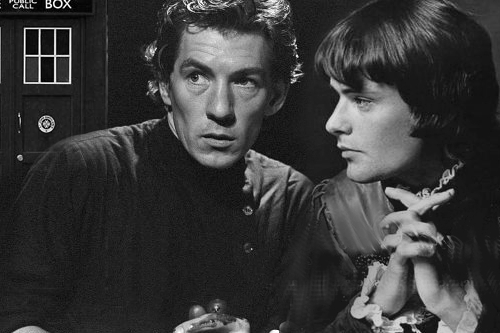
You can only watch so much Space Hamlet before you grow weary with Space Hamlet Fatigue, and after three seasons of glooming up space and time, Ian McKellan moved on. The show began as a lighthearted way to fund David Niven’s yam-yam habit and teach eight-year-olds about Oliver Cromwell, but by 1968 it had descended into dark gothic Shakespeare-in-Space weirdness. Viewers were ready for a change, and the BBC obliged.

The producers wanted the re-vamped show to draw more of the teen market, so they threw off the darkness and wholeheartedly embraced the weirdness, as the show reached new heights of trippiness with the Fourth Doctor, Peter Cook. Cook’s Doctor was basically Niven’s Doctor whacked out on space-acid, and many of the episodes are frankly impossible to describe. One of the most highly regarded Third Doctor story arcs was “Robots of Rigel,” a moving allegory on slavery and a story of what it means to be human. The Fourth Doctor revisited Rigel in “Rigellian Dawn” and

found the robots had left, and Rigel was overrun with giant caterpillars, which his companion, Tansy, taught to dance. Among other things, the Doctor at one point has a conversation with a giant mushroom voiced by Ringo Starr (a big fan of the show, who almost became the Sixth Doctor). A deeply moving allegory it was not, but who cares. The show was so deeply strange it seems no BBC executives were actually watching or supervising it at all. Unfortunately, in 1971 one of them must have caught a glimpse of it or seen an invoice or something. Cook’s contract was not renewed.
The Canada Years, 1972-1980
The show went on hiatus in 1971, and when it returned there were drastic changes: a new production crew, a new Doctor, and even a new country. To save costs, the production was moved to Canada. There was a return to more straightforward, linear storytelling, and a less eccentric Doctor: journeyman actor Jack Cassidy.
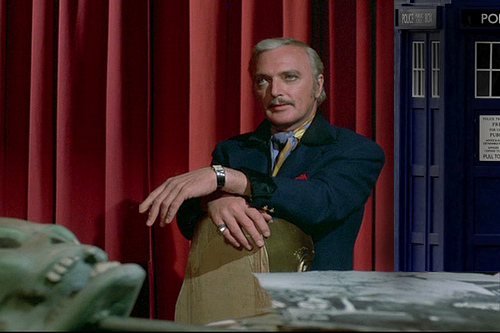
Honestly, a lot of Dr. Who fans are too hard on the Jack Cassidy years. Sure, it didn’t have the hyper-creative weirdness of the Cook era, but it was competently produced, and Cassidy had a soothing charm. Ignore the haters and watch the Fifth Doctor for yourself. Besides, your typical Cassidy episode was Citizen Fucking Kane compared to the horror that was to come…
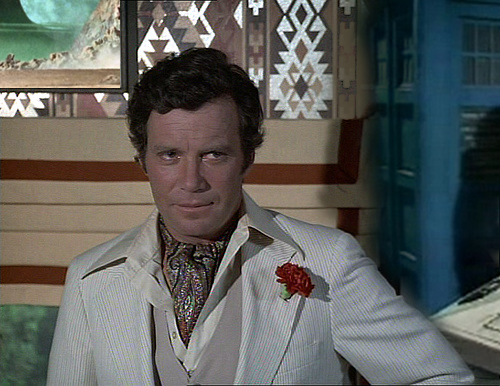
Jesus Christ, I don’t even know where to begin. Jack Cassidy died in 1975, and the producers turned to obscure Canadian character actor William Shatner. (True nerds might recognize him as the starship Enterprise captain in the unsold Star Trek pilot). He started off as sort of a shoutier version of Cassidy’s Sixth Doctor, and then he became… well, words cannot describe his acting style.
There are, however, words to describe the production design. Words like “hideous,” “ghastly,” and “blinding” spring to mind. I mean, look at his goddamned TARDIS. It’s decorated with lighted mixing bowls. Who thought that was a good idea?

Perhaps I’m being too hard on the Shatner era. Every TV show in say, 1978, was hideous. Then again, those mixing bowls! LOOK AT THEM. MY GOD.
For some reason, though, this iteration of the Doctor was weirdly popular. If you went to a science fiction convention in the 1980s, this was the Dr. Who cosplay that you saw. Dumpy guys in ill-fitting white suits outnumbered sad goth kids in whatever the hell weird smock Ian McKellan wore by at least four to one. This was the standard by which Dr. Who was judged. And this was the legacy that future versions would struggle to overcome, and finally, embrace.
NEXT TIME:
We look at Dr. Who through the Eighties…
- A new Doctor for for a new decade…
- Back to Britain!
- “The Time of the Four Doctors” Christmas Special!
- The Disastrous American Movie! And more!
